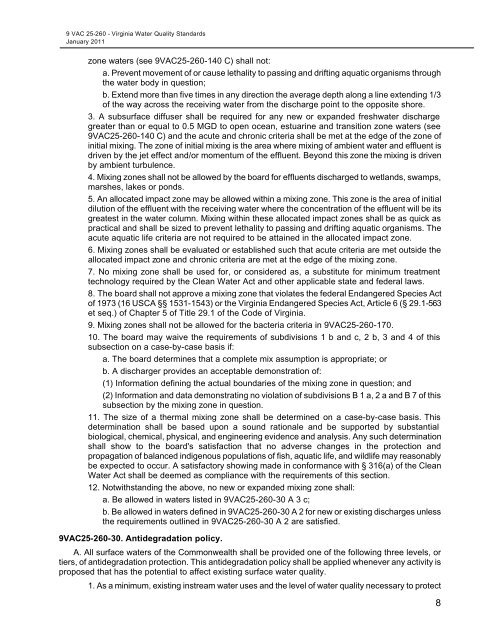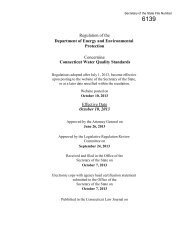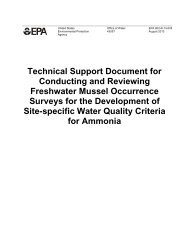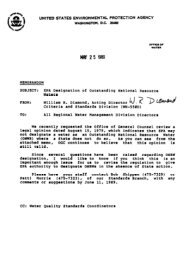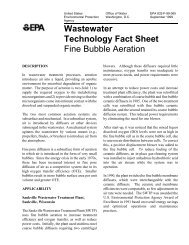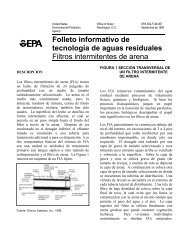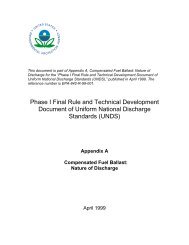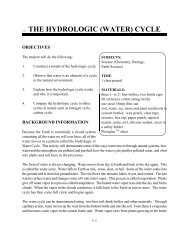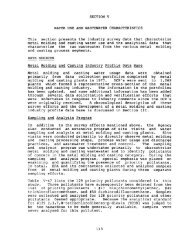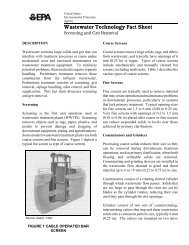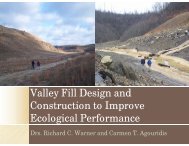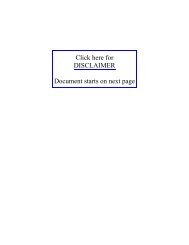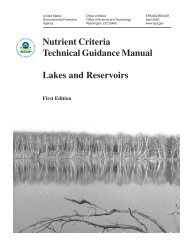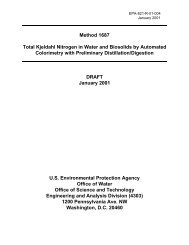Virginia Water Quality Standards - Water - US Environmental ...
Virginia Water Quality Standards - Water - US Environmental ...
Virginia Water Quality Standards - Water - US Environmental ...
Create successful ePaper yourself
Turn your PDF publications into a flip-book with our unique Google optimized e-Paper software.
9 VAC 25-260 - <strong>Virginia</strong> <strong>Water</strong> <strong>Quality</strong> <strong>Standards</strong><br />
January 2011<br />
zone waters (see 9VAC25-260-140 C) shall not:<br />
a. Prevent movement of or cause lethality to passing and drifting aquatic organisms through<br />
the water body in question;<br />
b. Extend more than five times in any direction the average depth along a line extending 1/3<br />
of the way across the receiving water from the discharge point to the opposite shore.<br />
3. A subsurface diffuser shall be required for any new or expanded freshwater discharge<br />
greater than or equal to 0.5 MGD to open ocean, estuarine and transition zone waters (see<br />
9VAC25-260-140 C) and the acute and chronic criteria shall be met at the edge of the zone of<br />
initial mixing. The zone of initial mixing is the area where mixing of ambient water and effluent is<br />
driven by the jet effect and/or momentum of the effluent. Beyond this zone the mixing is driven<br />
by ambient turbulence.<br />
4. Mixing zones shall not be allowed by the board for effluents discharged to wetlands, swamps,<br />
marshes, lakes or ponds.<br />
5. An allocated impact zone may be allowed within a mixing zone. This zone is the area of initial<br />
dilution of the effluent with the receiving water where the concentration of the effluent will be its<br />
greatest in the water column. Mixing within these allocated impact zones shall be as quick as<br />
practical and shall be sized to prevent lethality to passing and drifting aquatic organisms. The<br />
acute aquatic life criteria are not required to be attained in the allocated impact zone.<br />
6. Mixing zones shall be evaluated or established such that acute criteria are met outside the<br />
allocated impact zone and chronic criteria are met at the edge of the mixing zone.<br />
7. No mixing zone shall be used for, or considered as, a substitute for minimum treatment<br />
technology required by the Clean <strong>Water</strong> Act and other applicable state and federal laws.<br />
8. The board shall not approve a mixing zone that violates the federal Endangered Species Act<br />
of 1973 (16 <strong>US</strong>CA §§ 1531-1543) or the <strong>Virginia</strong> Endangered Species Act, Article 6 (§ 29.1-563<br />
et seq.) of Chapter 5 of Title 29.1 of the Code of <strong>Virginia</strong>.<br />
9. Mixing zones shall not be allowed for the bacteria criteria in 9VAC25-260-170.<br />
10. The board may waive the requirements of subdivisions 1 b and c, 2 b, 3 and 4 of this<br />
subsection on a case-by-case basis if:<br />
a. The board determines that a complete mix assumption is appropriate; or<br />
b. A discharger provides an acceptable demonstration of:<br />
(1) Information defining the actual boundaries of the mixing zone in question; and<br />
(2) Information and data demonstrating no violation of subdivisions B 1 a, 2 a and B 7 of this<br />
subsection by the mixing zone in question.<br />
11. The size of a thermal mixing zone shall be determined on a case-by-case basis. This<br />
determination shall be based upon a sound rationale and be supported by substantial<br />
biological, chemical, physical, and engineering evidence and analysis. Any such determination<br />
shall show to the board's satisfaction that no adverse changes in the protection and<br />
propagation of balanced indigenous populations of fish, aquatic life, and wildlife may reasonably<br />
be expected to occur. A satisfactory showing made in conformance with § 316(a) of the Clean<br />
<strong>Water</strong> Act shall be deemed as compliance with the requirements of this section.<br />
12. Notwithstanding the above, no new or expanded mixing zone shall:<br />
a. Be allowed in waters listed in 9VAC25-260-30 A 3 c;<br />
b. Be allowed in waters defined in 9VAC25-260-30 A 2 for new or existing discharges unless<br />
the requirements outlined in 9VAC25-260-30 A 2 are satisfied.<br />
9VAC25-260-30. Antidegradation policy.<br />
A. All surface waters of the Commonwealth shall be provided one of the following three levels, or<br />
tiers, of antidegradation protection. This antidegradation policy shall be applied whenever any activity is<br />
proposed that has the potential to affect existing surface water quality.<br />
1. As a minimum, existing instream water uses and the level of water quality necessary to protect<br />
8


